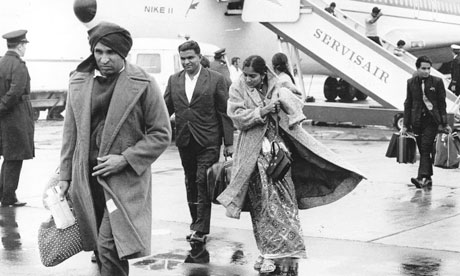
His byline was always E Hamilton West, which led some readers to think he had a touch of blue blood, but Ted West, who has died aged 78, was a member of a more refined aristocracy. He was a press photographer for more than 40 years, the last 26 of which were spent at the Guardian, a career that stretched from the days of plate cameras and glass negatives to the beginnings of digital photography.
He was born in Dulwich and remained a south Londoner all his life. His father, Richard West, died before his birth, and his mother, Marie, later married Horace Hamilton. The blitz disrupted Ted's education at Haberdashers' Aske's school, and, after several near misses, he was evacuated.
Ted had dreams of becoming a journalist and, at the age of 15, he took a job as a messenger on the London Evening Standard, moving on to become a darkroom assistant. This was before the days of film, when photographers with their 5x4 MPPs and Speed Graphic cameras would travel to a job with eight double dark slides (sheet film holders) made of glass in a pack slung over their shoulder. The cameras would be set in advance at a speed of 1/250th second; an aperture of f-8 and the lens at two or three yards. The slides took several seconds to change, so a cameraman frequently had only one chance at a picture. It was this equipment that Ted used when, on his Saturdays off, he began to cover football matches and tried to sell his pictures to photographic agencies. One of those agencies, Barratt's, gave him his first job as a photographer.
In 1962 he began working for the tough and demanding John Lacey at Central Press Photos. The young Ted, returning with his exposed film, would nervously await Lacey's yelled acerbic comments from the floor above. It was perhaps fortunate that he gained the support and friendship of the older and more experienced Denis Aulds, known to Ted as "Squire Aulds". They shared a car, taking it in turns to travel to jobs. Sometimes Ted would act as Denis's runner and watch in increasing alarm as Denis waited until the last moment before pressing the shutter. From Denis, he learned about straightforwardness and simplicity. The experience of these agency days never left him and informed his sense that you only needed one picture to tell a story.
In 1970 the picture editor John Pilkington offered Ted a job on the Guardian. In those days, the newspaper had terrible half-tone reproduction which presented real challenges to the photographers. Nevertheless, they were encouraged to go out and think differently from the rest of the pack, and Ted loved the opportunities that this offered. In the evening, Pilkington would quietly pass Ted a note saying: "Go and have a look at that tomorrow – see what you can make of it." The next day, Ted would return with his straightforward and telling images. They lacked pretentiousness or photographic artifice, spoke for themselves as pictures, and, in their way, helped to ground a newspaper sometimes accused of being too refined for its own good.
One of his earliest assignments was the scene of a suspected car bomb in Whitehall. As Ted raised his camera, the bomb exploded. His first picture was a blur but the second caught the blast perfectly. With his unthreatening personality, he was particularly good at photographing women. He also produced a fine series on expelled Ugandan Asians as they arrived in Britain in 1972, but could reliably have turned his hand to anything.
In many ways, Ted was an odd choice for a Guardian photographer. His background in a rough and ready, competitive Fleet Street sometimes grated with the sensibility of the university-educated elite who mostly ran the paper, but those who cared to look harder beneath that often misunderstood quality of self-depreciation noted his down-to-earth sensitivity, even when he would occasionally interrupt their carefully tuned interviews with pertinent comments.
Always dressed in a sports jacket, he was known for his catchphrases: "You're only as good as your last picture", "Never volunteer, never run for a bus and never pass a toilet", and, when he decided to go home, "Time I had a look at Sidcup parish church." He greatly enjoyed office repartee and humour and was immensely proud to work for the Guardian. He retired from the paper in 1996.
Ted is survived by his wife, Diane, and his children, Stephen and Helen.
Martin Wainwright writes: In 1976 Ted West took me on my first Guardian job outside the office. He was a breezy Londoner with an accent so strong that I thought we would spend the whole drive to Milton Keynes talking in rhyming slang. When we arrived and unloaded his gear, he fished out a battered leather attache case of the kind I associate with diplomats or cabinet ministers, and on it was tooled in faded gold: E Hamilton West.
"Are you E Hamilton West?" I asked incredulously. The byline had struck me since my teens. It had to be an old Etonian ex-officer whose renegade politics had taken him to the Guardian. No, it was Ted, who had been persuaded at the start of his career that a broadsheet would be happier with a sonorous name.
He was a gent all right, though. Training on local papers and the London Evening Standard gave me a lifelong love of working with snappers, good companions who see things I miss. Ted was the best, and in later years when I blew into head office, I always got the same London crack and the same wide grin.
• Albert Edward West, photographer, born 29 March 1933; died 19 May 2011
• Gallery of 13 photographs taken by E Hamilton West for the Guardian

